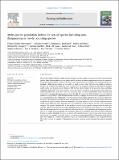Files in this item
Multi-species population indices for sets of species including rare, disappearing or newly occurring species
Item metadata
| dc.contributor.author | Korner-Nievergelt, Fränzi | |
| dc.contributor.author | Strebel, Nicolas | |
| dc.contributor.author | Buckland, Stephen T. | |
| dc.contributor.author | Freeman, Robin | |
| dc.contributor.author | Gregory, Richard D. | |
| dc.contributor.author | Guélat, Jérôme | |
| dc.contributor.author | Isaac, Nick | |
| dc.contributor.author | Mc Rae, Louise | |
| dc.contributor.author | Roth, Tobias | |
| dc.contributor.author | Schirmer, Saskia | |
| dc.contributor.author | Soldaat, Leo L. | |
| dc.contributor.author | Voříšek, Petr | |
| dc.contributor.author | Sattler, Thomas | |
| dc.date.accessioned | 2022-06-07T12:30:08Z | |
| dc.date.available | 2022-06-07T12:30:08Z | |
| dc.date.issued | 2022-07 | |
| dc.identifier | 279836811 | |
| dc.identifier | f2b36fc5-7c68-448b-86ae-4365bfd06a0c | |
| dc.identifier | 85131096676 | |
| dc.identifier.citation | Korner-Nievergelt , F , Strebel , N , Buckland , S T , Freeman , R , Gregory , R D , Guélat , J , Isaac , N , Mc Rae , L , Roth , T , Schirmer , S , Soldaat , L L , Voříšek , P & Sattler , T 2022 , ' Multi-species population indices for sets of species including rare, disappearing or newly occurring species ' , Ecological Indicators , vol. 140 , 109005 . https://doi.org/10.1016/j.ecolind.2022.109005 | en |
| dc.identifier.issn | 1470-160X | |
| dc.identifier.other | RIS: urn:09AE07B419FECFBB16053E7D55A1A50D | |
| dc.identifier.other | ORCID: /0000-0002-9939-709X/work/114023249 | |
| dc.identifier.uri | https://hdl.handle.net/10023/25498 | |
| dc.description | Funding Information: NI is funded by Natural Environment Research Council award NE/R016429/1 as part of the UK-SCAPE programme delivering National Capability | en |
| dc.description.abstract | Multi-species indices (MSI) are widely used as ecological indicators and as instruments to inform environmental policies. Many of these indices combine species-specific estimates of relative population sizes using the geometric mean. Because the geometric mean is not defined when values of zero occur, usually only commoner species are included in MSIs and zero values are replaced by a small non-zero value. The latter can exhibit an arbitrary influence on the geometric mean MSI. Here, we show how the compound Poisson and the negative binomial model can be used in such cases to obtain an MSI that has similar features to the geometric mean, including weighting halving and doubling of a species’ population equally. In contrast to the geometric mean, these two statistical models can handle zero values in population sizes and thus accommodate newly occurring and temporarily or permanently disappearing species in the MSI. We compare the MSIs obtained by the two statistical models with the geometric mean MSI and measure sensitivity to changes in evenness and to population trends in rare and abundant species. Additionally, we outline sources of uncertainty and discuss how to measure them. We found that, in contrast to the geometric mean and the negative binomial MSI, the compound Poisson MSI is less sensitive to changes in evenness when total abundance is constant. Further, we found that the compound Poisson model can be influenced more than the other two methods by trends of species showing a low interannual variance. The negative binomial MSI is less sensitive to trends in rare species compared with the other two methods, and similarly sensitive to trends in abundant species as the geometric mean. While the two new MSIs have the advantage that they are not arbitrarily influenced by rare, newly appearing and disappearing species, both do not weight all species equally. We recommend replacing the geometric mean MSI with either compound Poisson or negative binomial when there are species with a population size of zero in some years having a strong influence on the geometric mean MSI. Further, we recommend providing additional information alongside the MSIs. For example, it is particularly important to give an evenness index in addition to the compound Poisson MSI and to indicate the number of disappearing and newly occurring species alongside the negative binomial MSI. | |
| dc.format.extent | 11 | |
| dc.format.extent | 3971087 | |
| dc.language.iso | eng | |
| dc.relation.ispartof | Ecological Indicators | en |
| dc.subject | Multi-species population indicator | en |
| dc.subject | Tweedie compound Poisson distribution | en |
| dc.subject | Negative binomial distribution | en |
| dc.subject | Log-normal distribution | en |
| dc.subject | Geometric mean | en |
| dc.subject | Population size of zero | en |
| dc.subject | Count of zero | en |
| dc.subject | Zero-count | en |
| dc.subject | QA Mathematics | en |
| dc.subject | QL Zoology | en |
| dc.subject | Ecology, Evolution, Behavior and Systematics | en |
| dc.subject | Decision Sciences(all) | en |
| dc.subject | Ecology | en |
| dc.subject | DAS | en |
| dc.subject.lcc | QA | en |
| dc.subject.lcc | QL | en |
| dc.title | Multi-species population indices for sets of species including rare, disappearing or newly occurring species | en |
| dc.type | Journal article | en |
| dc.contributor.institution | University of St Andrews. School of Mathematics and Statistics | en |
| dc.contributor.institution | University of St Andrews. Scottish Oceans Institute | en |
| dc.contributor.institution | University of St Andrews. St Andrews Sustainability Institute | en |
| dc.contributor.institution | University of St Andrews. Centre for Research into Ecological & Environmental Modelling | en |
| dc.contributor.institution | University of St Andrews. Marine Alliance for Science & Technology Scotland | en |
| dc.identifier.doi | https://doi.org/10.1016/j.ecolind.2022.109005 | |
| dc.description.status | Peer reviewed | en |
This item appears in the following Collection(s)
Items in the St Andrews Research Repository are protected by copyright, with all rights reserved, unless otherwise indicated.

